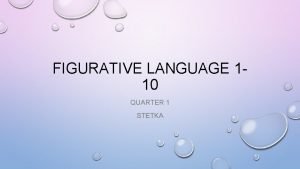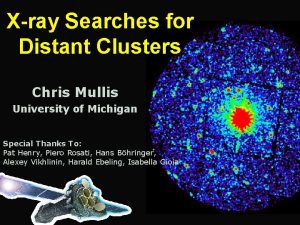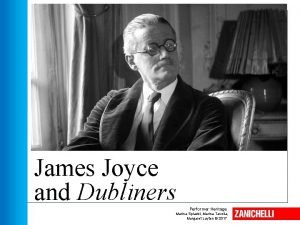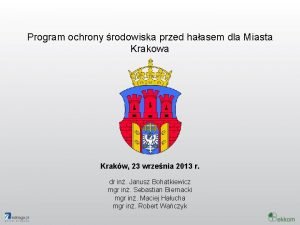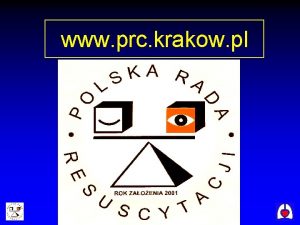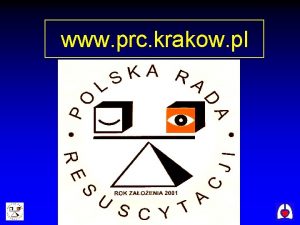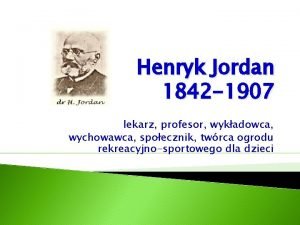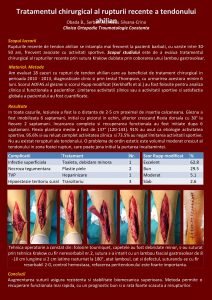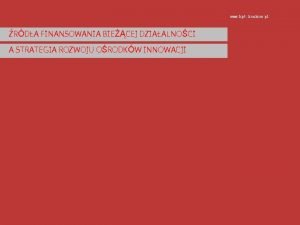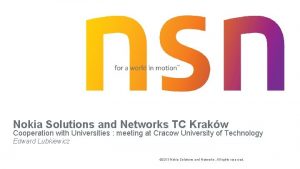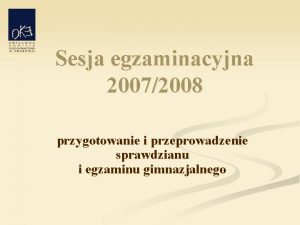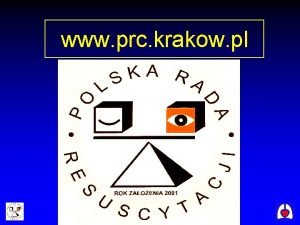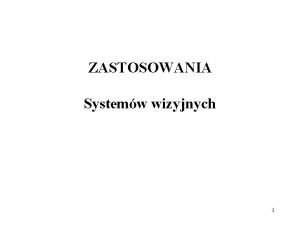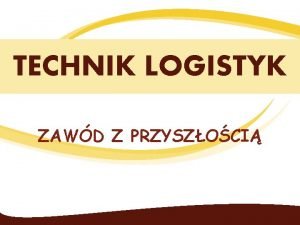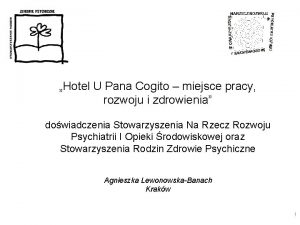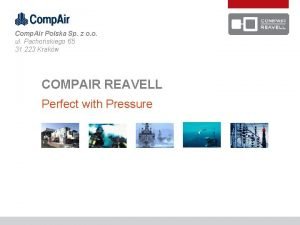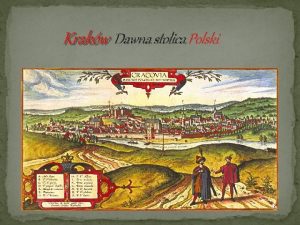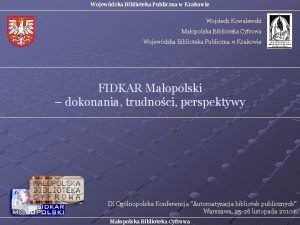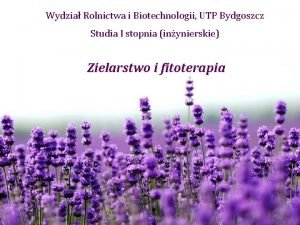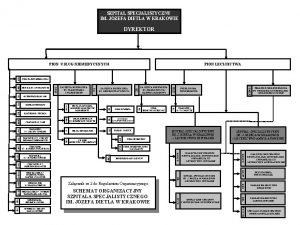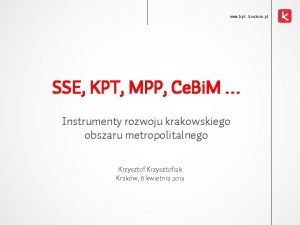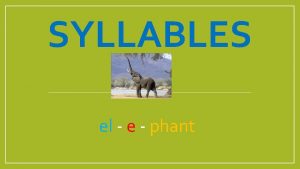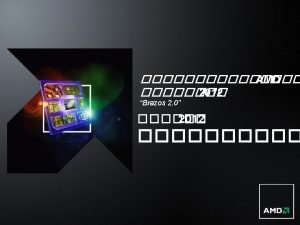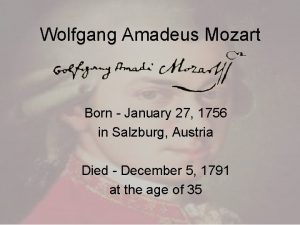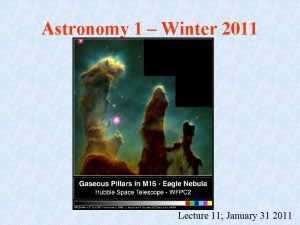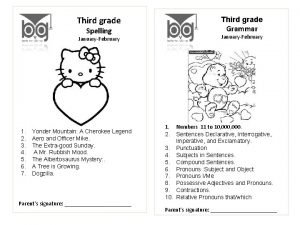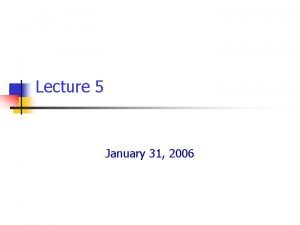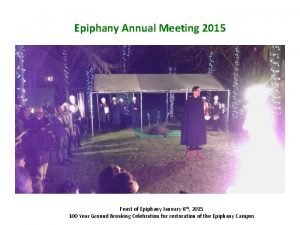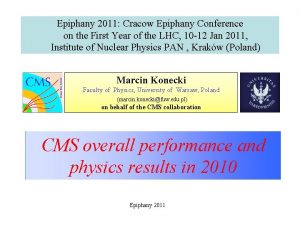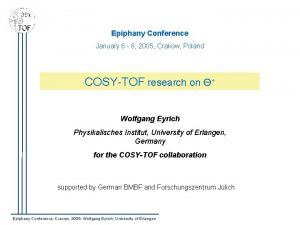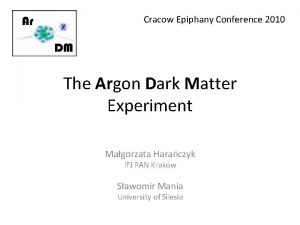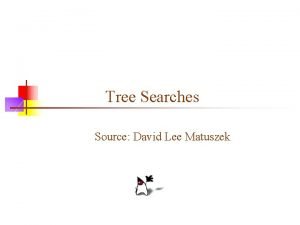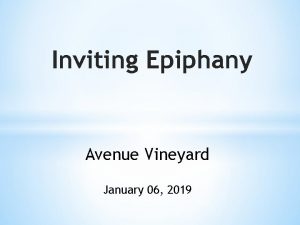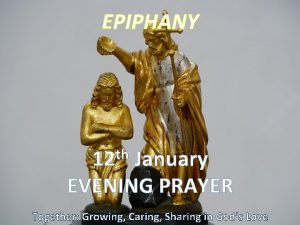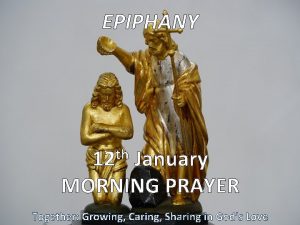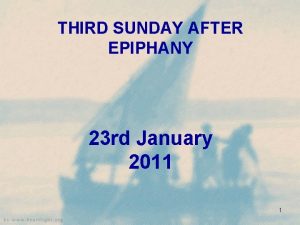Epiphany Conference Krakow 6 th January 2010 Searches



















![Predicted rate C = |M 0 n|2 • G 0 n [y-1] C [y-1] Predicted rate C = |M 0 n|2 • G 0 n [y-1] C [y-1]](https://slidetodoc.com/presentation_image_h2/e2475d459b0080c081b35daab6b4fe25/image-20.jpg)





























- Slides: 49

Epiphany Conference Krakow 6 th January 2010 Searches for Neutrinoless Double Beta Decay Andrea Giuliani University of Insubria (Como) and INFN Milano-Bicocca Italy

Outline Ø Neutrino mass and Double Beta Decay Ø Experimental challenge and strategies Ø Present situation Ø Overview of the future projects Ø Some very promising experimental approaches Ø Prospects and conclusions

Outline Ø Neutrino mass and Double Beta Decay Ø Experimental challenge and strategies Ø Present situation Ø Overview of the future projects Ø Some very promising experimental approaches Ø Prospects and conclusions

Neutrino flavor oscillations what we presently know from neutrino flavor oscillations do occur neutrinos are massive given the three n mass eigenvalues M 1, M 2, M 3 we have approximate measurements of two DMij 2 (DMij 2 Mi 2 – Mj 2) DM 122 ~ (9 me. V)2 Solar |DM 232 | ~ (50 me. V)2 Atmospheric approximate measurements and/or constraints on Ulj n 3 n 2 n 1 ne nm nt elements of the n mixing matrix

Neutrino flavor oscillations and mass scale what we do not know from neutrino flavor oscillations: Degenerate m 1~m 2~m 3>>|mi-mj| Normal hierarchy m 3>> m 2~m 1 Inverted hierarchy m 2~m 1>>m 3 (m 3)2 neutrino mass hierarchy (Dm 2) (m 1)2 (m 2)2 (m 3)2 (m 2)2 12 (m 1)2 ? (Dm 2)23 (Dm 2)13 absolute neutrino mass scale (m 2)2 (Dm 2)12 (m 1)2 ? ? DIRAC or MAJORANA nature of neutrinos n n (m 3)2 ne nm nt

Decay modes for Double Beta Decay 2 nbb Two decay modes are usually discussed: (A, Z) (A, Z+2) + 2 e- + 2 ne 2 n Double Beta Decay allowed by the Standard Model already observed – t 1019 y 0 n bb (A, Z) (A, Z+2) + 2 e. Neutrinoless Double Beta Decay never observed (except a discussed claim) t > 1025 y Neutinoless process would imply new physics beyond the Standard Model violation of lepton number conservation It is a very sensitive test to new physics since the phase space term is much larger than for the standard process interest for 0 n-DBD lasts for more than 70 years ! Goeppert-Meyer proposed the standard process in 1935 Racah proposed the neutrinoless process in 1937

Double Beta Decay and neutrino physics DBD is a second order weak transition very low rates Diagrams for the two processes discussed above: Standard process two “simultaneous” beta decays 0 n-DBD a virtual neutrino is exchanged between the two electroweak lepton vertices

Neutrino properties and 0 n-DBD u d WW- d u ene ne a LH neutrino (L=1) is absorbed at this vertex a RH antineutrino (L=-1) is emitted at this vertex in pre-oscillations standard particle physics (massless neutrinos), the process is forbidden because neutrino has not the correct helicity / lepton number to be absorbed at the second vertex e- § IF neutrinos are massive DIRAC particles: Helicities can be accommodated thanks to the finite mass, BUT Lepton number is rigorously conserved § IF neutrinos are massive MAJORANA particles: Helicities can be accommodated thanks to the finite mass, AND Lepton number is not relevant Observation of 0 n-DBD mn 0 n n 0 n-DBD is forbidden 0 n-DBD is allowed

0 n-DBD and neutrino physics how 0 n-DBD is connected to neutrino mixing matrix and masses in case of process induced by mass mechanism neutrinoless Double Beta Decay rate Phase space Nuclear matrix elements Effective Majorana mass 1/t = G(Q, Z) |Mnucl|2 Mbb 2 < 0. 2 what the experimentalists try to measure what the nuclear theorists try to calculate parameter containing the physics Mbb = ||Ue 1 | 2 M 1 + ei | Ue 2 | 2 M 2 + ei |Ue 3 | 2 M 3 | 1 2

From where we start… S. Pascoli, S. T. Petcov and T. Schwetz, hep-ph/0505226 76 Ge claim excluded by CUORICINO , NEMO 3

…and where we want to go S. Pascoli, S. T. Petcov and T. Schwetz, hep-ph/0505226 Approach the inverted hierarchy region in a first phase ( m >50 me. V) Exclude the inverted hierarchy region in a second phase ( m >15 me. V) There are techniques and experiments in preparation which have the potential to reach these sensitivities

The size of the challenge S. Pascoli, S. T. Petcov and T. Schwetz, hep-ph/0505226 76 Ge 100 - 1000 counts / y ton claim 150 me. V 20 me. V 10 counts / y ton 0. 1 - 1 counts / y ton

Outline Ø Neutrino mass and Double Beta Decay Ø Experimental challenge and strategies Ø Present situation Ø Overview of the future projects Ø Some very promising experimental approaches Ø Prospects and conclusions

Electron sum energy spectra in DBD The shape of the two electron sum energy spectrum enables to distinguish among the two different discussed decay modes two neutrino DBD continuum with maximum at ~1/3 Q neutrinoless DBD peak enlarged only by the detector energy resolution sum electron energy / Q Q ~ 2 -3 Me. V for the most promising nuclides additional signatures: § single electron energy distribution § angular distribution

Background requirements To start to explore the inverted hierarchy region Sensitivity at the level of 1 -10 counts / y ton To cover the inverted hierarchy region Sensitivity at the level of 0. 1 -1 counts / y ton The order of magnitude of the target bakground is ~ 1 counts / y ton

Experimental strategies Detect and identify the daughter nuclei (indirect search) geochemical experiments radiochemical experiments it is not possible to distinguish the decay channel important in the 70 s-80 s – no more pursued now Detect the two electrons with a proper nuclear detector (direct search) desirable features § high energy resolution a peak must be revealed over background (0 n-DBD) shield cosmic rays (direct interactions and activations) underground § low background § large source (many nuclides under control) very radio-pure materials 238 U – 232 Th t ~ 1010 y signal rate t > 1025 y § event reconstruction method present more sensitive experiments: 10 - 100 kg future goals: ~ 1000 kg 1027 – 1028 nuclides § reject background § study electron energy and angular distributions

Experimental approaches to direct searches Two approaches: constraints on detector materials very large masses are possible demonstrated: up to ~ 50 kg proposed: up to ~ 1000 kg e- e- Source Detector (calorimetric technique) § § scintillation phonon-mediated detection solid-state devices gaseous detectors e- detector source e- detector Source Detector § § scintillation gaseous TPC gaseous drift chamber magnetic field and TOF with proper choice of the detector, very high energy resolution Ge-diodes bolometers in gaseous/liquid xenon detector, indication of event topology in contradiction neat reconstruction of event topology it is difficult to get large source mass several candidates can be studied with the same detector

Experimental sensitivity to 0 n-DBD sensitivity F: lifetime corresponding to the minimum detectable number of events over background at a given confidence level b 0 live time b: specific background coefficient [counts/(ke. V kg y)] b=0 energy resolution source mass F (MT / b. DE)1/2 F MT importance of the nuclide choice (but large uncertainty due to nuclear physics) sensitivity to M (F/Q |Mnucl |2)1/2 Q 1/2 1 |Mnucl| b. DE MT 1/4

Choice of the nuclide Transition energy (Me. V) 5 Isotopic abundance (%) 40 4 20 3 Nuclear Matrix Element 2 48 Ca 76 Ge 82 Se 96 Zr 100 Mo 116 Cd 130 Te 136 Xe 150 Nd 0 48 Sign of convergence! Ca 76 Ge 82 Se 96 Zr 100 Mo 116 Cd 130 Te 136 Xe 150 Nd
![Predicted rate C M 0 n2 G 0 n y1 C y1 Predicted rate C = |M 0 n|2 • G 0 n [y-1] C [y-1]](https://slidetodoc.com/presentation_image_h2/e2475d459b0080c081b35daab6b4fe25/image-20.jpg)
Predicted rate C = |M 0 n|2 • G 0 n [y-1] C [y-1] the real figure of merit: the higher the better No superisotope! 76 Ge 82 Se 100 Mo 116 Cd 130 Te 136 Xe 150 Nd

Outline Ø Neutrino mass and Double Beta Decay Ø Experimental challenge and strategies Ø Present situation Ø Overview of the future projects Ø Some very promising experimental approaches Ø Prospects and conclusions

ee- High energy resolution (<2%) No tracking capability Source Detector Easy to approach the ton scale Easy to reject 2 n DBD background Heidelberg-Moscow CUORICINO NEMO-3 e- detector source e- detector Source Detector Easy to get tracking capability Low energy resolution (>2%) Tracking / topology capability Easy to approach zero backround (with the exception of 2 n DBD component)

The Heidelberg Moscow experiment Source = detector Well established technology of Ge diodes Ø Five Ge diodes for an overall mass of 10. 9 kg isotopically enriched ( 86%) in 76 Ge Ø Underground operation in the Gran Sasso laboratory (Italy) A subset of the HD collaboration (H. V. Klapdor. Kleingrothaus et al. ) in 2001 announces a discussed claim Ø Ø Ø 71. 7 kg year – Bkg: 0. 11 counts / (kg y ke. V) - Signal: 28. 75 ± 6. 87 events (Bkg: ~60) Claim: 4. 2 s evidence T 1/2 = (0. 69– 4. 18) x 1025 y (3 s) Best fit: T 1/2 = 1. 19 x 1025 y (NIMA 522/PLB 586) PSA analysis (Mod. Phys. Lett. A 21): (2. 23 + 0. 44 – 0. 31)x 1025 y Tuebingen/Bari group (PRD 79): Mbb [e. V] = 0. 28 [0. 17 -0. 45] 90%CL

The Heidelberg Moscow experiment: criticisms The claimed peak at 2039 ke. V Significance and T 1/2 depend on Bkg model Ø Chkvorets, Ph. D dissertation Univ. HD (2008) using realistic background model peak significance reduced to 1. 3 s, T 1/2 = 2. 2 x 1025 y Ø Strumia & Vissani Nucl. Phys. B 726 (2005)

CUORICINO Source = detector Bolometric technique: young (born in ~ 1985) but now firmly established Nuclide under study: 130 Te A. I. : 34% enrichment not necessary The sensitive part of the detector is a crystal of Te. O 2 Bolometric technique: the nuclear energy is measured as a temperature increase of a single crystal DT = E/C thanks to a proper thermometer, DT DV In order to get low specific heat, the temperature must be very low (5 – 10 m. K) Typical signal sizes: 0. 1 m. K / Me. V, converted to about 1 m. V / Me. V

Energy absorber single Te. O 2 crystal § 790 g § 5 x 5 cm Thermometer (doped Ge chip) Sensitive mass: 41 kg

CUORICINO results 60 Co sum peak MT = 18 kg 130 Te y 2505 ke. V ~ 3 FWHM from DBD Q-value Bkg = 0. 18± 0. 02 c/ke. V/kg/y 130 Te 0 nbb T 1/2 (y) > 2. 94 1024 y (90% c. l. ) Mbb < 0. 20 – 0. 68 e. V

NEMO 3: the structure Source detector Well established technologies in particle detection: - tracking volume with Geiger cells - plastic scintillators - magnetic field Ø Different sources in form of foil can be used simultaneously Ø Underground operation in the Frejus laboratory (France) Ø Water and iron shields The sources 1 SOURCE 2 TRACKING VOLUME 3 CALORIMETER detector scheme

NEMO 3: the results NEMO 3 is a real 2 nbb factory → seven 2 nbb decays observed and studied Results with the strongest source (100 Mo) F. Mauger, TAUP 2009

Present results and Klapdor’s claim

Outline Ø Neutrino mass and Double Beta Decay Ø Experimental challenge and strategies Ø Present situation Ø Overview of the future projects Ø Some very promising experimental approaches Ø Prospects and conclusions

Experiments and techniques rise time distribution e- FAST surface events e- High energy resolution (<2%) Source Detector Nooperated tracking capability Array of low temperature natural Te. O 2 calorimeters at 10 m. K CUORE - 130 Te First step: Kg (2012) – LNGS – it can take advantage from 2 n Cuoricino experience Easy to approach the 200 ton scale Easy to reject DBD background Proved energy resolution: 0. 25 % FWHM GERDA - 76 Gethese experiments do not have tracking capability, some space Even though Array of enriched diodes in liquidthe nitrogen or liquid argonto: information and Ge other tools operated help in reducing background thanks First phase: 18 Kg; ofsecond phase: 40 Kg - LNGS GRANULARITY the basic design Proved energy resolution: 0. 16 % FWHM bolometers - CUORE: 988 closed packed individual MAJORANA - 76 Ge - COBRA: 64, 000 closed packed individual detectors Array of enriched Ge diodespacked operated in conventional Cumodule cryostats - MAJORANA: 57 closed individual diodes per SLOW Based on- SHAPE 60 detector Kg modules; first step: 2 x 60 Kg modules PULSE DISCRIMINATION e bulk events Proved energy resolution: can 0. 16 separate % FWHMsingle / multi site - GERDA / MAJORANA events source 116 COBRA - Cd competing candidate – 9 bb isotopes SEGMENTATION and PIXELLIZATION e- Cd Array of 116 enriched Cd. Zn. Te of semiconductor detectors at room temperatures Granularity can be achieved through electrodes segmentation detector Low 116 Final aim: in 117 kg of for Cd. GERDA, MAJORANA, COBRAenergy resolution (>2%) R&D progress Small scale. SHIELDING prototype at LNGS Tracking / topology capability ACTIVE Source Detector Easy to approach zero backround Proved energy 1. 9% FWHM - GERDA: Geresolution: diodes operated in active LAr Easy to get tracking capability 100 bolometers (with the exception of SURFACE- 82 SENSITIVITY LUCIFER Se – 116 Cd – in Mo DBD - R&D in progress bolometers in CUORE against energy-degraded orand b component) background Array of scintillating operated at 10 m. K (Zn. Se 2 n Cd. WO 4 or Zn. Mo. O 4) Simultaneous PHONON detection in performed bolometersby S. Pirro in LNGS First step: 20 Kg. LIGHT (2013)and – LNGS – based on R&D - LUCIFER / 0. 25 rejection power already demonstrated Proved energy. Excellent resolution: % FWHM

Experiments and techniques ee- Source Detector Easy to approach the ton scale High energy resolution (<2%) No tracking capability Easy to reject 2 n DBD background CANDLES – 48 Ca Array of natural pure (not Eu doped) Ca. F 2 scintillators Prove of principle completed (CANDLES I and II) Next step (CANDLES III): under commissioning 305 kg divided in 96 crystals read by 40 PMT Further step (CANDLES IV: requires R&D): 6. 4 tons divided in 600 crystals: 6. 4 Kg of 48 Ca Final goal (CANDLES V): 100 ton (SNO, Kamland. . . ) Proved energy resolution: 3. 4 % FWHM (extrapolated from 9. 1 % at 662 ke. V) detector e- is The good point of this search the high Q-value of 48 Ca: 4. 27 Me. V out of (2. 6 Me. V end point), source b (3. 3 Me. V end point) and (max 2. 5 Me. V with quench) natural radioactivity Other background cuts come from PSD ( /b different timing) and space-time correlation for Bi-Po and Bi-Tl e- detector Source Detector Easy to get tracking capability Low energy resolution (>2%) Tracking / topology capability Easy to approach zero backround (with the exception of 2 n DBD component)

Experiments and techniques ee- Source Detector EXO - 136 Xe High energy resolution (<2%) No tracking capability TPC of Easy enriched liquid Xenon to approach the ton scale Easy to reject 2 n DBD background Event position and topology; in prospect, tagging of Ba single ion (DBD daughter) only 2 n DBD background Next step (EXO-200: funded, under commissioning): 200 kg – WIPP facility – sensitivity: 270 -380 me. V Further steps: 1 -10 ton Proved energy resolution: 3. 3 % FWHM (inproved thanks to simultaneous measurement of ionization and light) In parallel with the EXO-200 development, R&D for Ba ion grabbing and tagging Ba++ e- e- final state is identified through optical spectroscopy NEXT - 136 Xe High pressure gas TPC e- detector Total mass: 80 kg Aims at energy resolution downsource to 1% To be installed in CANFRANC in 2013 e- detector Source Detector Easy to get tracking capability Low energy resolution (>2%) Tracking / topology capability Easy to approach zero backround (with the exception of 2 n DBD component)

Experiments and techniques ee- Source Detector Easy to approach the ton scale High energy resolution (<2%) No tracking capability Easy to reject 2 n DBD background XMASS – 136 Xe Multipurpose scintillating liquid Xe detector (Dark Matter, Double Beta Decay, solar neutrinos) Three development stages: 3 Kg (prototype) 1 ton 10 ton DBD option: low background in the Me. V region Special development with an eliptic water tank to shield high energy gamma rays High light yield and collection efficiency energy resolution down to 1. 4% control 2 n background Target: to cover inverted hierarchy with 10 ton natural or 1 ton enriched SNO+ – 150 Nd e- detector SNO detector filled with Nd-loaded liquid scintillator source 0. 1% loading with natural Nd -→ 56 Kg of isotope e detector Very interesting and original approach. Low energy resolution (>2%) Crucial points: Nd enrichment and purity; 150 Nd nuclear matrix elements Source Detector Easy to get tracking capability Tracking / topology capability Easy to approach zero backround (with the exception of 2 n DBD component)

Experiments and techniques SUPERNEMO - 82 Se or 150 Nd Modules with source foils, tracking (drift chamber in Geiger mode) and calorimetric (low Z scintillator) sections Magnetic field for chargee-sign Possible configuration: 20 modules with 5 kg source for each module 100 Kg in Modane extension Energy resolution: 4 % FWHM eit can take advantage of NEMO 3 experience High energy resolution (<2%) MOON - 100 Mo or 82 Se or 150 Nd Source Detector tracking capability Multilayer plastic scintillators interleaved with source foils + tracking No section (PL fibers or MWPC) Easy to approach the ton scale Easy to reject 2 n DBD background MOON-1 prototype without tracking section (2006) MOON-2 prototype with tracking section Proved energy resolution: 6. 8 % FWHM PM Final target: collect 5 y x ton DCBA - 82 Se or 150 Nd Momentum analyzer for beta particles consisting of source foils inserted in a drift chamber with magnetic field Prototype: Nd 2 O 3 foils 1. 2 g of 150 Nd Space resolution ~ 0. 5 mm; energy resolution 11% FWHM at 1 Me. V 6 % FWHM at 3 Me. V Final target: 10 modules with 84 m 2 source foil for module (126 through 330 Kg total mass) e- detector source e- detector Source Detector Easy to get tracking capability Low energy resolution (>2%) Tracking capability Easy to approach zero backround (with the exception of 2 n DBD component) rs

Outline Ø Neutrino mass and Double Beta Decay Ø Experimental challenge and strategies Ø Present situation Ø Overview of the future projects Ø Some very promising experimental approaches Ø Prospects and conclusions

From CUORICINO to CUORE (Cryogenic Underground Observatory for Rare Events) CUORE = closely packed array of 988 detectors 19 towers - 13 modules/tower - 4 detectors/module M = 741 kg Compact structure, ideal for active shielding Each tower is a CUORICINO-like detector Special dilution refrigerator

CUORE funding and schedule Ø CUORE has a dedicated site in LNGS and the construction has started Ø The CUORE refrigerator will be commissioned in 2010 Ø 1000 crystals are funded by INFN and Do. E and the delivery has started Ø The first CUORE tower (CUORE-0) will be assembled and operated in 2010 CUORE data taking is foreseen in 2013

CUORE sensitivity Surface background problem partially / fully solved Background in 0 nbb region (optimistic estimate) 0. 001 c/ke. V/kg/y Background in 0 nbb region (conservative estimate) 0. 01 c/ke. V/kg/y CUORE can attack the inverted hierarchy region of the neutrino pattern Detector resolutionmass ~ 5 ke. V Live time 5 years T 1/20 n (130 Te) > 2. 1 x 1026 y mββ < 44 - 73 me. V T 1/20 n (130 Te) > 6 x 1026 y mββ < 25 - 43 me. V

Super. NEMO structure Ø 5 - 7 kg of bb isotope per module Ø Drift wire chamber operating in Geiger mode + plastic scintillators coupled to low radioactivity PMTs Ø 20 - 22 modules for the full detector → 100 – 150 kg of isotope in total Ø modules surrounded by water shielding Ø location: LSM (France) in one of the two new hall after the extension Ø demonstrator operational in 2011

Super. NEMO sensitivity Improvement with respect to NEMO-3 NEMO 3 ISOTOPE MASS (kg) ENERGY RES. (FWHM) EFFICIENCY BACKGROUND (c / ke. V kg y) 2 nbb 7 8% @ 3 Me. V SUPERNEMO 100 -200 4 % @ 3 Me. V 18 % 30 % 10 -3 10 -4 0. 7 x 10 -3 0. 75 x 10 -4 3 m. Bq/m 3 (20) 0. 1 m. Bq/m 3 208 Tl < 20 m. Bq/kg 214 Bi < 300 m. Bq/kg 10 m. Bq/kg Radon Baseline: 82 Se T 1/20 n (130 Te) > 1 – 1. 5 x 1026 y mββ < 43 - 145 me. V Other options: 150 Nd – 48 Ca → advanced enrichment technologies

Scintillating bolometers: LUCIFER 76 Ge 130 Te -region 116 Cd -region 100 Mo 82 Se Environmental “underground” Background: 238 U and 232 Th contaminations CUORICINO Background Q-value > 2. 6 Me. V + alpha tagging “zero” background

Scintillating bolometers: concepts

Scintillating bolometers: the discrimination power Scatter plot of light signals vs. heat signal Alpha light yield < beta light yield Alpha light yield > beta light yield

Scintillating bolometers: test devices Light Detector 3 x 3 x 3 Cd. WO 4 3 x 3 x 6 Cd. WO 4

LUCIFER structure and sensitivity Single module

Outline Ø Neutrino mass and Double Beta Decay Ø Experimental challenge and strategies Ø Present situation Ø Overview of the future projects Ø Some very promising experimental approaches Ø Prospects and conclusions

Future scenarios and branching points in terms of discovery sensitivity to M experimental situation if this range holds: 76 Ge claim is right): if this range holds (or if degenerate hierarchy Super. NEMO could marginally see it in 82 Se or 150 Nd 76 - GERDA 100 -200 phase I /kg II will see it in Ge isotope - 5 year scale 100 - 500 me. V 150 Nd SNO++ could see it in 82 Se or 150 Nd) - Super. NEMO may investigate the mechanism ( CUORE -III GERDA I / II 116 - in EXO 200 - Super. NEMO - LUCIFER 76 Ge GERDA phase could see it 82 - LUCIFER will see it in Se or Cd 130 - CUOREwill could - EXO-200 seemarginally it in 136 Xe see it in Te, but could clearly 82 Se or 116 detect it in see to LUCIFER-mode - SNO+ could it in 150 Cd Ndif- upgraded inverted hierarchy atmospheric DM 2 region discovery 3 orin 4 130 isotopes necessary (and possible. . . ) - CUORE willin see Te- 10 andyear may do 15 - 50 me. V 1000 kg itisotope scale toifconfirm the observation and to improve Mbb estimate this range holds: multi-isotope searches simultaneously straightforward in some cases (enriched CUORE) 130 116 100 new strategies have to be developed ( Te - GERDA Cd - phase Mo) III – EXO final – CUORE in LUCIFER mode - it scale is worthwhile to start to elaborate them now large enrichment required - next generation experiments are 2 precious reduction of uncertainties in NME direct hierarchy - solar DM region for the selection of the future approaches precision measurement era 0 n-DBD! required big leap in sensitivity - newfor approaches 2 - 5 me. V - a large investment in enrichment is mandatory 100 tons of isotopes is the typical scale discovery if neutrino is a Majorana particle unpredictable time scale
 Is characterization figurative language
Is characterization figurative language 2711 se loop 410 south
2711 se loop 410 south How does poland celebrate the epiphany
How does poland celebrate the epiphany Xray searches
Xray searches Summary of chapter 8 of great gatsby
Summary of chapter 8 of great gatsby The dead the dubliners
The dead the dubliners Bildungsroman coming of age
Bildungsroman coming of age Reflective writing style
Reflective writing style Performer heritage blu
Performer heritage blu Epiphany health direct primary care
Epiphany health direct primary care Customer experience management conference 2011
Customer experience management conference 2011 Prc.krakow
Prc.krakow Mapa akustyczna krakowa
Mapa akustyczna krakowa Prc.krakow
Prc.krakow Www.prc.krakow.pl
Www.prc.krakow.pl Ogród jordanowski kraków
Ogród jordanowski kraków Ahilian
Ahilian Rda.krakow.pl
Rda.krakow.pl Inicjatywa mikro kraków
Inicjatywa mikro kraków Wciągnięte brodawki kraków
Wciągnięte brodawki kraków Nokia solutions and networks kraków
Nokia solutions and networks kraków Oke kraków obieg
Oke kraków obieg Rytmy do defibrylacji
Rytmy do defibrylacji Stava śledzenie
Stava śledzenie Jak wygląda kraków
Jak wygląda kraków U pana cogito
U pana cogito Wahadło foucaulta kraków
Wahadło foucaulta kraków Compair kraków
Compair kraków Kraków dawna stolica polski
Kraków dawna stolica polski Biblioteka wojewódzka kraków
Biblioteka wojewódzka kraków Zielarstwo i fitoterapia inżynierskie
Zielarstwo i fitoterapia inżynierskie Szpital specjalistyczny im. józefa dietla kraków
Szpital specjalistyczny im. józefa dietla kraków Fbu london ssa gov
Fbu london ssa gov Jcj,b
Jcj,b Mpp kraków
Mpp kraków Syllable of elephant
Syllable of elephant Jill kally
Jill kally January 24th 1848
January 24th 1848 Respect character trait
Respect character trait 9 months before january 26 2009
9 months before january 26 2009 June 2012 chemistry regents answers
June 2012 chemistry regents answers January 2012
January 2012 Arvod cannot find work as a mall santa in january.
Arvod cannot find work as a mall santa in january. He was born in salzburg austria on january 27 1756
He was born in salzburg austria on january 27 1756 Spatial january
Spatial january An asset was purchased for $120 000 on january 1
An asset was purchased for $120 000 on january 1 January february spelling
January february spelling Sunday, tuesday, january, saturday
Sunday, tuesday, january, saturday January february march
January february march January 31 2006
January 31 2006
